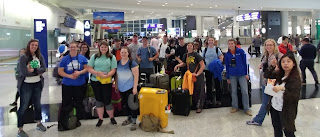May 11
May 11, 2017
Last night
the group attended the Hong Kong Jockey Club horse races. They run 8 races
every Wednesday night. Each race's betting pool was around $25-35 million Hong
Kong dollars (around $4 million U.S.). There were large bleachers and several
air conditioned boxes, many of us went down and stood right along the track
fence, so it was a very up-and-close experience.
We all took
a taxi back to the hotel, everyone in Hong Kong drives very fast, the speed
limit is around 80 kph (50 mph). Surprisingly as fast and wild as everyone
drives, we never really saw any vehicles that were scratched or dented. Also,
there were quite a few exotic cars such as Lamborghini’s.
Today we
ate breakfast at the hotel we stayed at, the breakfast was very good and
included a variety of foods like western, Indian, and Chinese. One thing we
noticed about the restaurants so far is they all have many mirrors on the walls
as well as marble/granite on the floors and walls.
We checked
out of the hotel after breakfast and got on a bus headed for the Hong Kong/
China Mainland border. Once we reached the border we went through a strict
customs area, they checked passports and scanned all of our luggage. After that
we got on a different bus and headed through the new booming city of Shenzhen,
we are officially in China! Many people live in Shenzhen and cross the customs
border and work in Hong Kong. Shenzhen is very industrial with many
manufacturing plants. The city grew from 15 thousand people to 25 million
people in 40 years. Jocelyn, our tour guide, laughed and said, "That when
you refer to something fast in China, they now refer it to Shenzhen
speed." A 30 story apartment can be built in just a month and a half so
the city is constantly changing and growing!
With many hills, and a hole in one of the coolant lines, which was fixed
by wrapping a piece of plastic around it, our bus became over heated on our way
to the fish farm. We poured several bottles of water into the radiator and
eventually it cooled off enough to take off again. After about a half hour, the
bus overheated again. We had no water left so the bus driver started walking
with a couple empty jugs. While we waited, our tour guide arranged for a
different bus to come get us. Mechanic Grant tried to help the bus driver,
while Lucas climbed the trees and the rest of us stood and observed.
The fish
farm came and picked us up in another bus and we headed to the South China Sea
Research Institution. We then went to a dock, got on a few small boats and went
out into the bay where they had 80 round cages that they grew fish in. The main
fish were called Pomphrey fish. These fish were used for producing eggs which
would be gathered and hatched in a different area. They said these cages were
about 15' deep and 25' across. We then went back to the dock and toured the
fish farms research buildings. In these buildings, they grew things like
shrimp, sea horses, different types of coral, and fish. They research different
things like reproduction, salt content, and water temperatures.
With having
the bus break down, we didn't have time to stop at the buffet for dinner, so we
stopped at a very small supermarket and got things like ice cream, chips,
peanuts, pop and tea for dinner. It took us around 2 hours to get to the
Guangzhou Port Nansha Grain and General Cargo Terminal. At the Port we met with
Mr. Lee, the operations director of the port. The port was built in 2011 and
receives products such as soybeans, corn, barley, distiller’s grains, and coal.
The port has a handling capacity of 27 million tons per year. The larger boats
that bring in the product can hold up to 58,000 tons and the smaller
distributer boats can hold around 5,000 tons. The product must remain at the
port for 15 days and then can be distributed to other cities in China by the
smaller boats. The port runs 24 hours a day 7 days a week with around 600
workers with both contracted and official workers. After the port tour we rode
the bus back to Guangzhou for a buffet supper and then checked into our new
hotel.
HK container
Ocean farm
Port
Research farm
Sea horse
Bus
General port
Grain













At Guangzhou Port Nansha, why is it that incoming product must sit for 15 days? Also, was "Mechanic Grant" one of our students? His offering of services is both amusing and awesome.
ReplyDelete